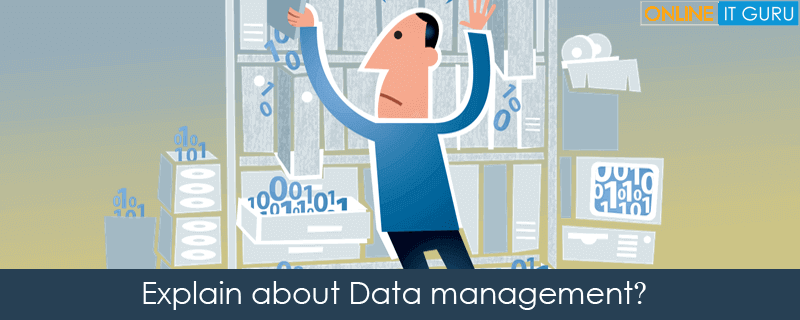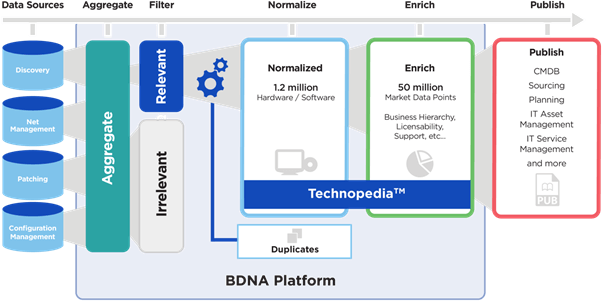
ServiceNow is a software platform and a good ticketing tool that helps to process several customer service requests. It is a cloud-based platform with ITIL guidelines and supports IT Business Management automation. Using tools like ServiceNow, users can raise the number of requests relating to products, changes, issues, incidents, etc.
Among them “Data Management” is one of the important processes within ServiceNow and it also involves several tools. The DM system is a sophisticated and powerful management tool with the capability of enormous storage, distribution, and analysis of sensitive company data. It includes products and services, information to employees, suppliers, etc. Moreover, it is a multiplatform process in different objectives.
These DM tools also integrate several other software platforms of the company with different features. Such as data analysis, data omission checking, observing file usage, and updating related apps & platforms.
DM includes several numbers of tools that we will discuss in this blog further.
Data Management:
Data in your instance is stored and managed by a principled structure that managers can view and configure. Administration functions include importing, exporting, and archiving database data and configuring fields and tables. To effectively manage and improve your systems, you have to know exactly what resources are in your IT condition and have present exact configuration data. With an exact configuration management database (CMDB), it's easy to understand your association's IT environment, especially in the areas of service impact analysis, resource management, compliance, and configuration management.
Get in touch with Online IT Guru for mastering the ServiceNow Online Training
The ServiceNow CMDB gives a single system of record for IT. At the point when combined with ServiceNow Service Mapping, the CMDB becomes service‑aware which empowers your ServiceNow applications to be service‑aware too. Presently with your CMDB, you increase the full visibility of your infrastructure and services, leading to more control of your environment and better choices.
Features
Below are some important features of Data management
The information stored in database tables and records.
Different tools exist to deal with this data.
The schema map displays CI relations graphically.
Data word reference tables store structure and relationship definitions.
Data import and export simplifies managing large data sets through import maps and various exportable formats.
Different modules give extra functionality.
For Instance, Field standardization makes records more reliable and prevents duplication of data.
It also includes mapping and linking various corporate contacts within and outside the business.
This helps in applying several business rules specific to the product and its management.
It also manages data locations for the storage and its usage in business activities based on different locations.
The management system also implements various data enrichment tools and techniques to make data more highly available. It helps users of data very much in this regard.
Database structure:
Especially the majority of the data in the instances is stored in tables, which consists of a series of records. As a matter of fact, the record thus holds a series of fields that hold the individual bits of information and can be viewed either as a list or a form.
The table can be related to each other in many ways:
Extensions:
Specifically, a table can extend another table. The table expanding incorporates the majority of the fields of the other table (parent class) and includes its own fields. In particular, For example, the Incident [incident] table has the majority of the Task [task] table fields (on the grounds that an occurrence is an exceptional type of errand) and has its own incident-specific tasks.
One – to – Many: A field can hold a reference to a record on another table within a table.
There are three types of one-to-many relationship fields.
Reference Field:
It enables a user to choose a record on a table defined by the reference field. For example, the Caller field on the Incident table enables the user to choose any record on the User table.
Glide List:
It enables a client to choose different records on a table characterized by the glide list. For Instance, the Watch list field on the Incident table enables the client to choose records on the User table.
Document ID Field:
It enables a user to choose a record on any table in the table. These fields are substantially less common, yet one example the Document field on the Translated Text [sys_translated_text] table.
Many- to - Many:
Generally, two tables can have a bi-directional relationship, with the goal that the related records visible from the two tables in a related list.
Database Views:
Two tables can be joined for all purposes with Database Views to enable reporting on data that may put away stored over more than one table.
Benefits of Data Management
There are many benefits of data management within ServiceNow. It’s very difficult for a company to manage huge data where data management systems play an important role. They are indispensable tools in managing huge data with a lot of good features. Moreover, they make better use of all the available resources within the company.
||{"title":"Master in ServiceNow", "subTitle":"ServiceNow Certification Training by ITGURU's", "btnTitle":"View Details","url":"https://onlineitguru.com/servicenow-online-training.html","boxType":"demo","videoId":"H1yv6o7ylow"}||
Here are a few benefits of Data management discussed below.
Handling large volume data
ServiceNow DM systems are capable of handling huge data. It’s no matter how much data a company can grow on a daily basis. The intelligent ServiceNow data management systems can handle it irrespective of quantity and data fields.
Global working facility
The ServiceNow DM tools and systems are best suited for remote workings. Having permission to access data, users can access any data from anywhere of the globe at any time. Users can use it on any device. Thus, these data management systems facilitate cloud-based functionalities to its users with the global working facility and data usage.
Eliminating data redundancies
It is difficult to find and eliminate any error or bug within huge data of the company. But this system helps in reducing data errors and makes the data cleanly available with 100% accuracy. For this, it uses automation processes that transform data redundancy into an accurate one.
High-level data security and privacy
The ServiceNow Data management systems and tools are efficient in providing data security and its privacy at a high-level. It is essential for a company to review that if it leaves such a huge data upon trusting the data management system. They need some back-up and have to apply some data safety measures before handing over data to the automated management system. In this regard, the data management systems are very efficient and behave intelligently.
Data Storage
They save a large amount of data on their own data storage system. Otherwise, users can subscribe to an external data storage facility like “Dropbox”. Generally, a company saves its data on various excel files and in different formats. So, it may cost the company something more than usual as it needs more space. But the data management systems offer their storage facility to the users with great benefit.
The DM system offers optimized data access facilities across the enterprise and also globally to its users. By incorporating data in a central database from other formats or exporting it to the central database may help users.
Thus, these are the few advantages of Data management in ServiceNow.
Moreover, there are some disadvantages to the data management system.
The major disadvantage includes that data management tools have many features useful for the enterprise-level business profile. This costs the business management in huge.
Another disadvantage of this system is that process implementation is very tricky within a company. Moreover, it requires persons with excellent training and skills to implement such solutions.
Before using a DM system, users must have to be familiar with it. After spending some time with this platform, testing the system’s working, etc. one can become an expert in it. Overall, it depends upon the complexity of the data available within the company.
Data management Tools:
There are a number of data a management tool that helps to manage the data.
Schema map:
Subsequently, The Schema Map shows the connections between tables visually, exploring through the database structure. The Schema Map gives an interface to review the connections between tables. The inter table connections it captures incorporate many-to-many relationships, tables that extend other tables, and tables that reference other tables through reference fields.
Data Dictionary Tables:
Simultaneously Data dictionary tables hold data that characterizes the database and can accesses data on the database schema.
Table Cleaner:
Simultaneously the system automatically records from particular tables after a particular time to deletion. Erasing these records naturally keeps the tables from developing to an unmanageable size. The time before a record deleted starts on the date and time value in the tracked field.
There are a few other types of data management tools available that help organizations in digitizing the various processes.
They are-
PIM- Product Information Management
MDM- Master Data Management
Data Modeling
Data Warehouse
Product Information Management
The PIM is an ultimate and powerful tool useful for manufacturers and retailers with a central control system. Within an automated ecosystem, the PIM manages all the business operations, activities, and processes. Such as maintaining, correcting, and analyzing product information, designing catalog programs, etc. across all the channels of business.
Master Data Management
These tools are helpful in managing the central or master data of the organization. Such as company accounts, business operations, activities, employees, regulations, and guidelines, etc. Moreover, the MDM management tools include cleansing data, data mapping, controlling transactions, domain support, etc. Besides, it also supports global data syncing. Most of the giant entities use this type of data management tool for their operations.
Data Modeling
The concept of data modeling includes changes in data within the company’s database as and when required. This DM tool enables users to produce conceptual data rules and procedures to smooth data consistency.
This is a must for any business unit for good data management.
||{"title":"Master in ServiceNow", "subTitle":"ServiceNow Certification Training by ITGURU's", "btnTitle":"View Details","url":"https://onlineitguru.com/servicenow-online-training.html","boxType":"reg"}||
Data Warehouse
The data warehouse within ServiceNow DM tool types is the data storage location of the company. This system is accountable for producing data storage for the company. These are useful for data storage only and they don’t provide any kind of analysis of the user data.
The data management tools have another aspect like arranging data according to the user needs. It will be in a particular model or the format that users require.
Thus, these tools help in managing huge data within any organization.
Conclusion
Thus, we have gone through the concept of Data Management within ServiceNow. It works on the automation system that eases the critical business operations and makes smoother data management. The concept of data management is very important to know for the people working with the ServiceNow platform. Due to its cloud-based nature, one can easily access and adopt it for business use. Some premium versions may need to pay for using. So, I hope you like this study on managing data and their tools useful in this regard. This is most useful to learn for ETL professionals, Analytical professionals, etc.
Trainers will teach you from the basics to advanced. Become a Master in ServiceNow at OnlineITGuru through ServiceNow online course
